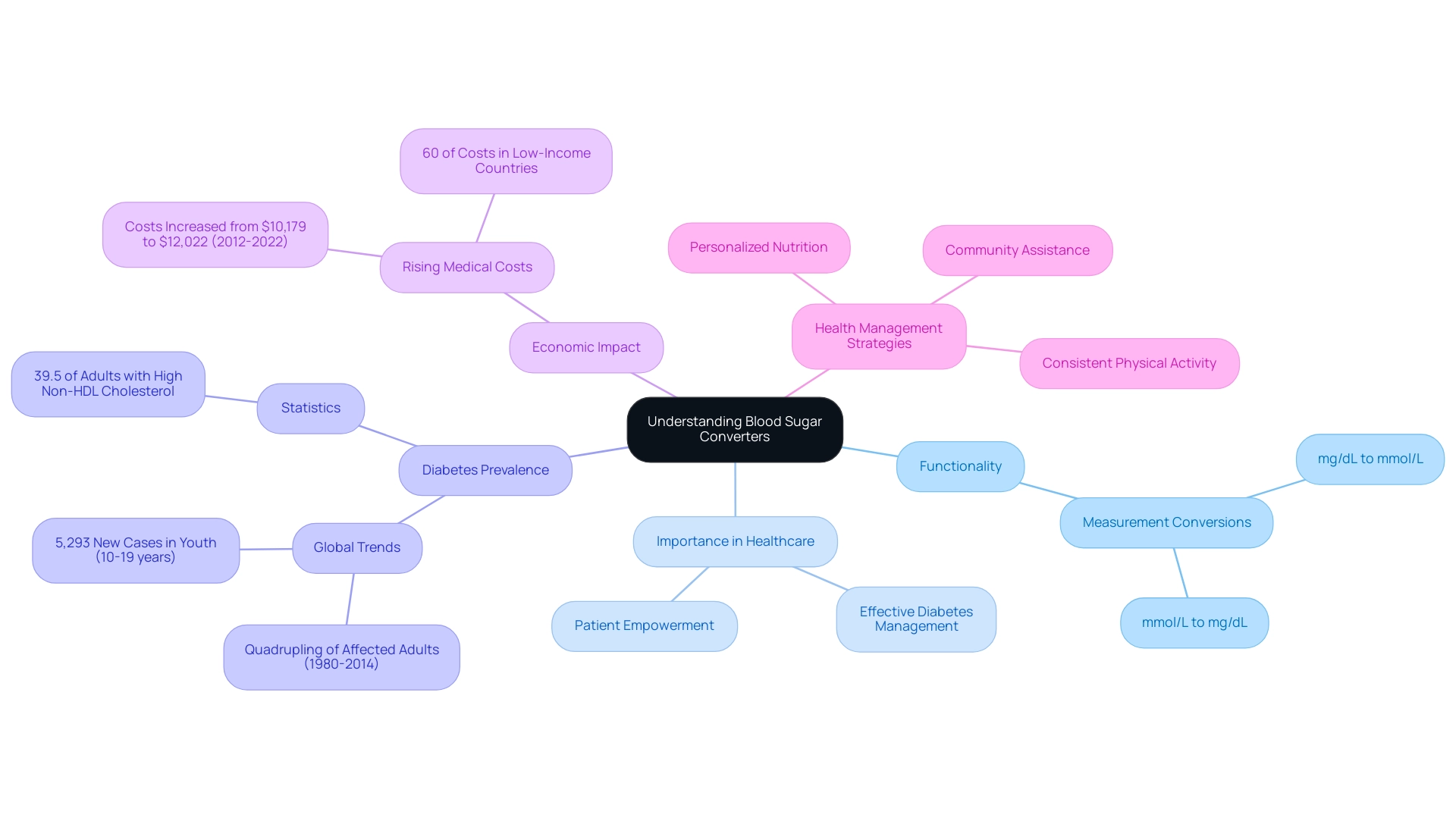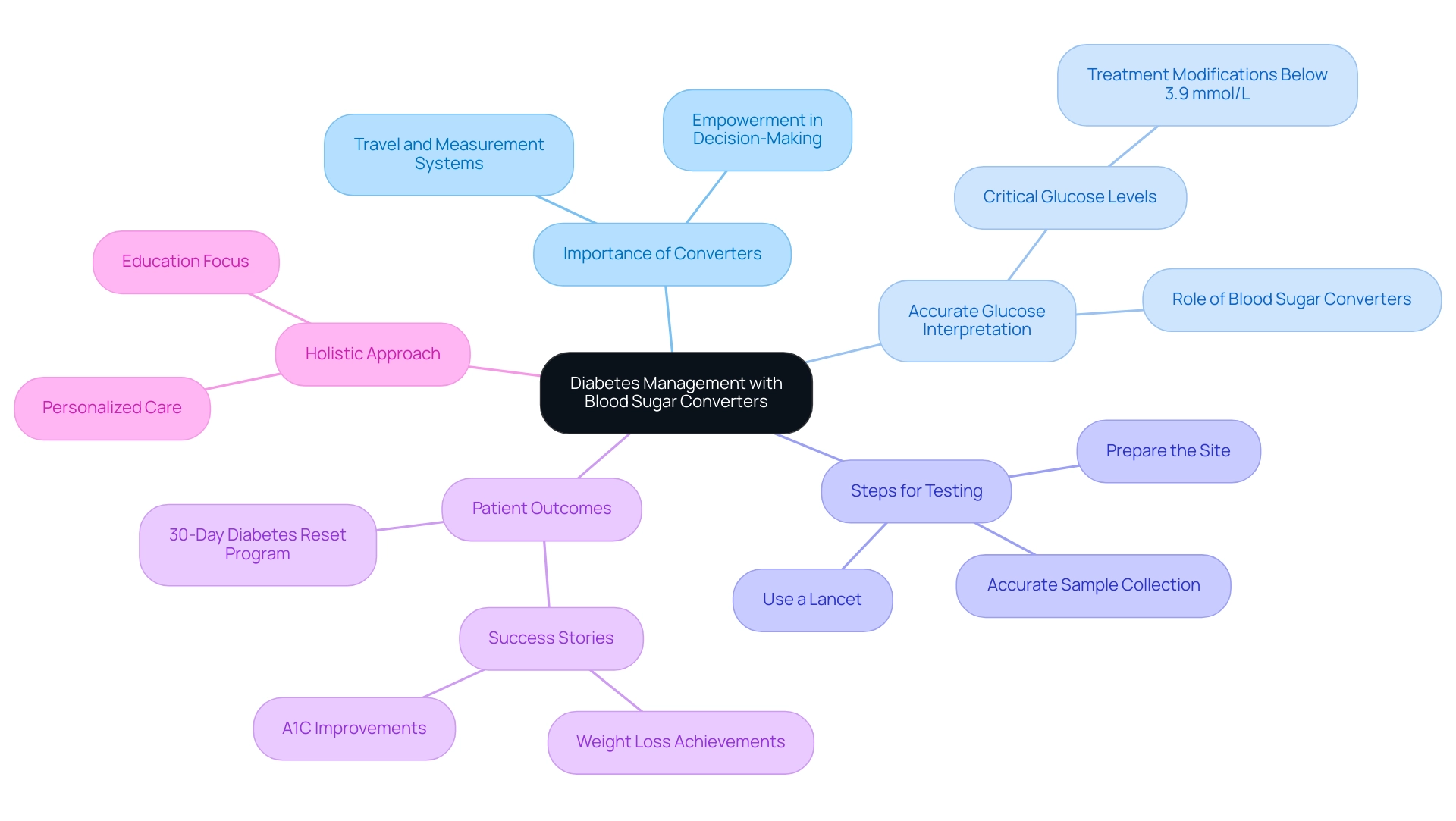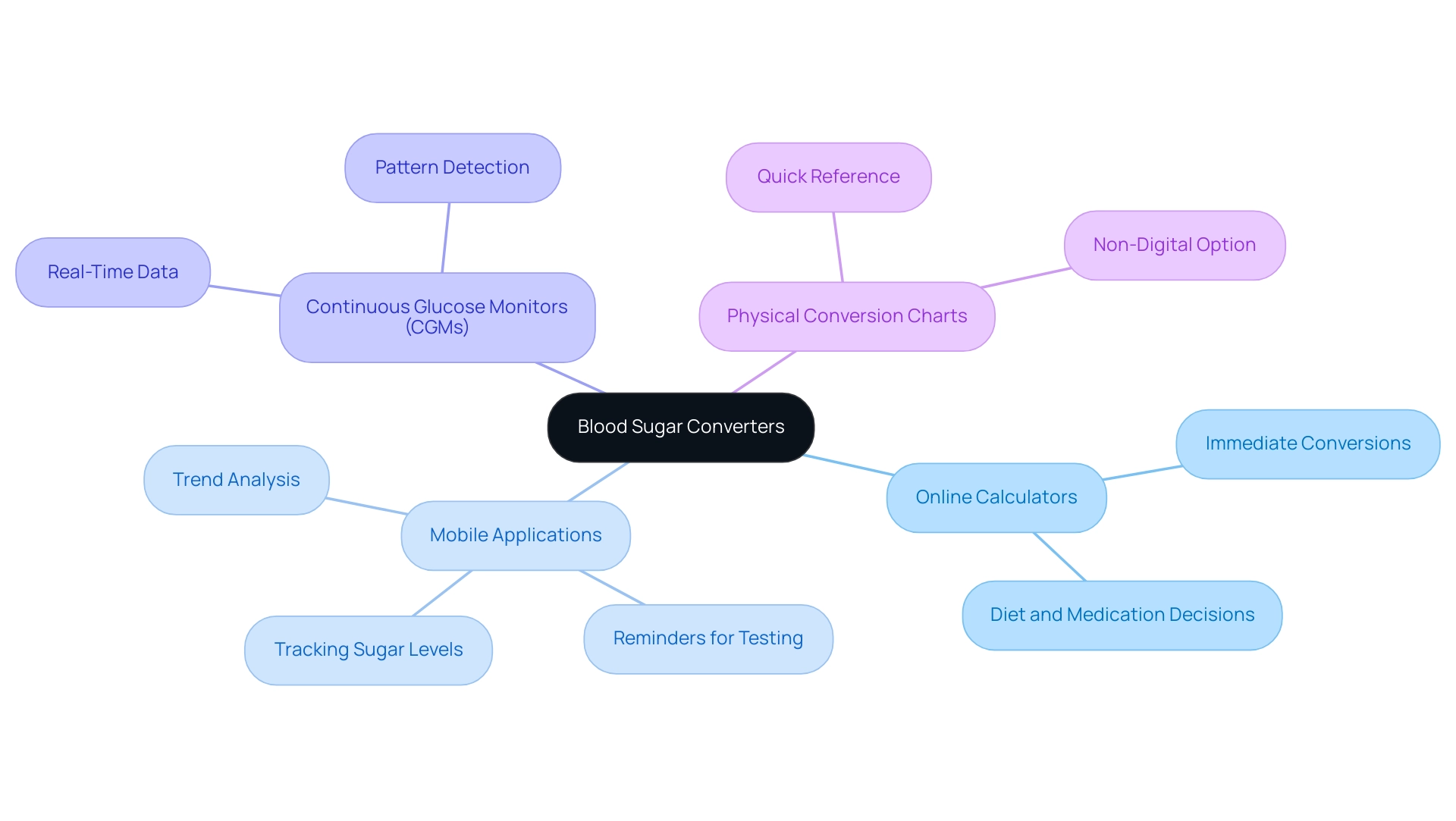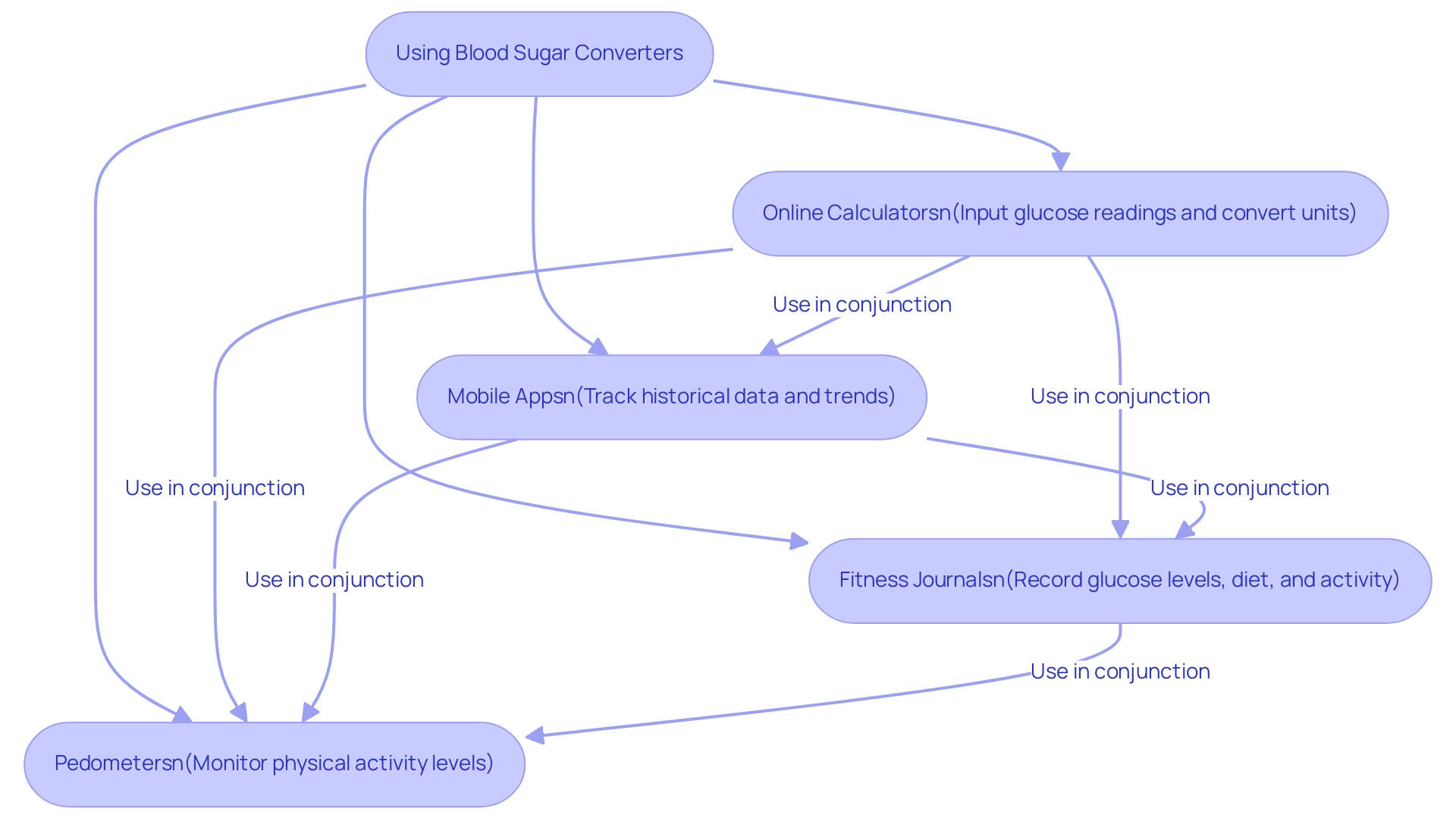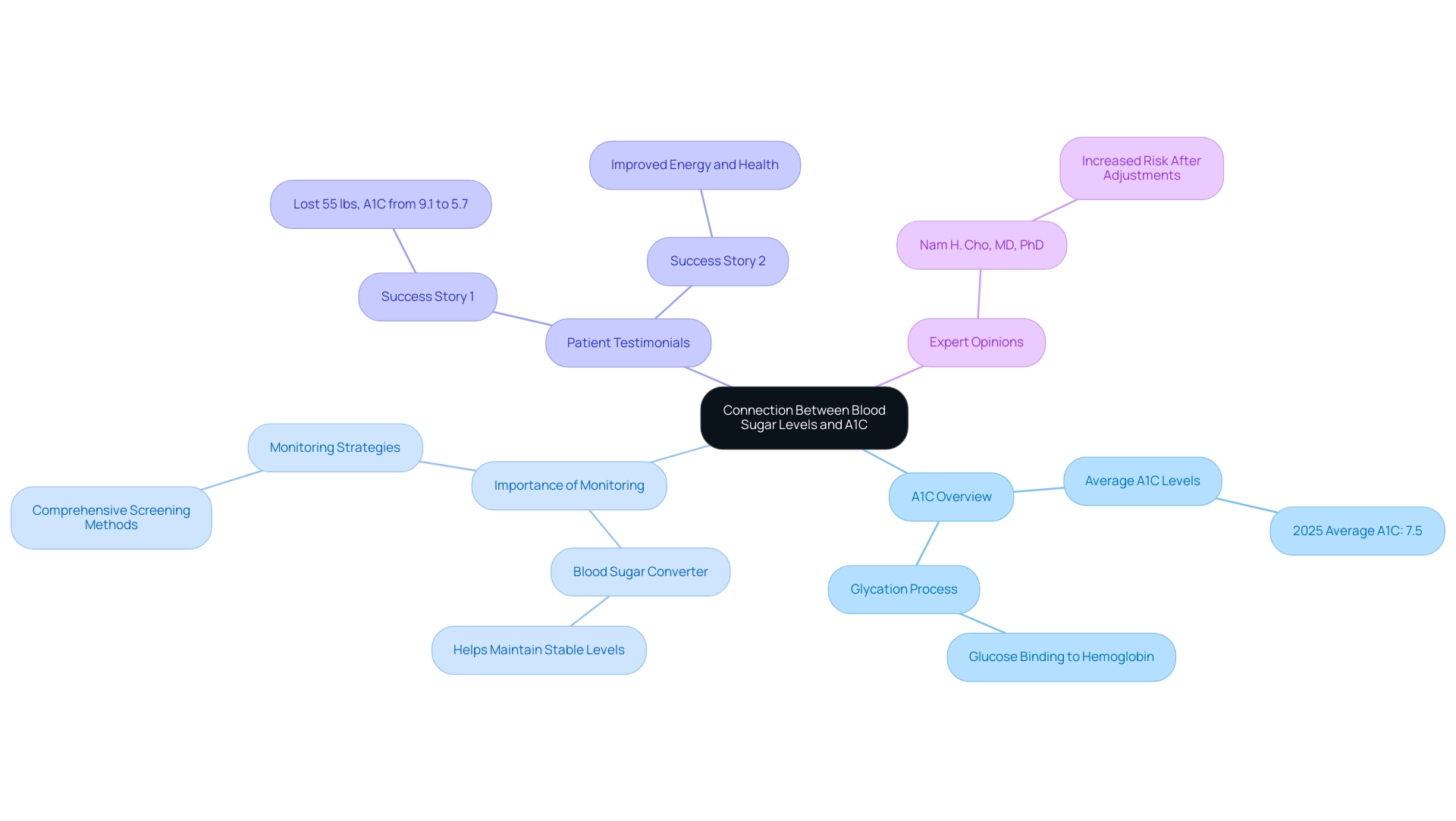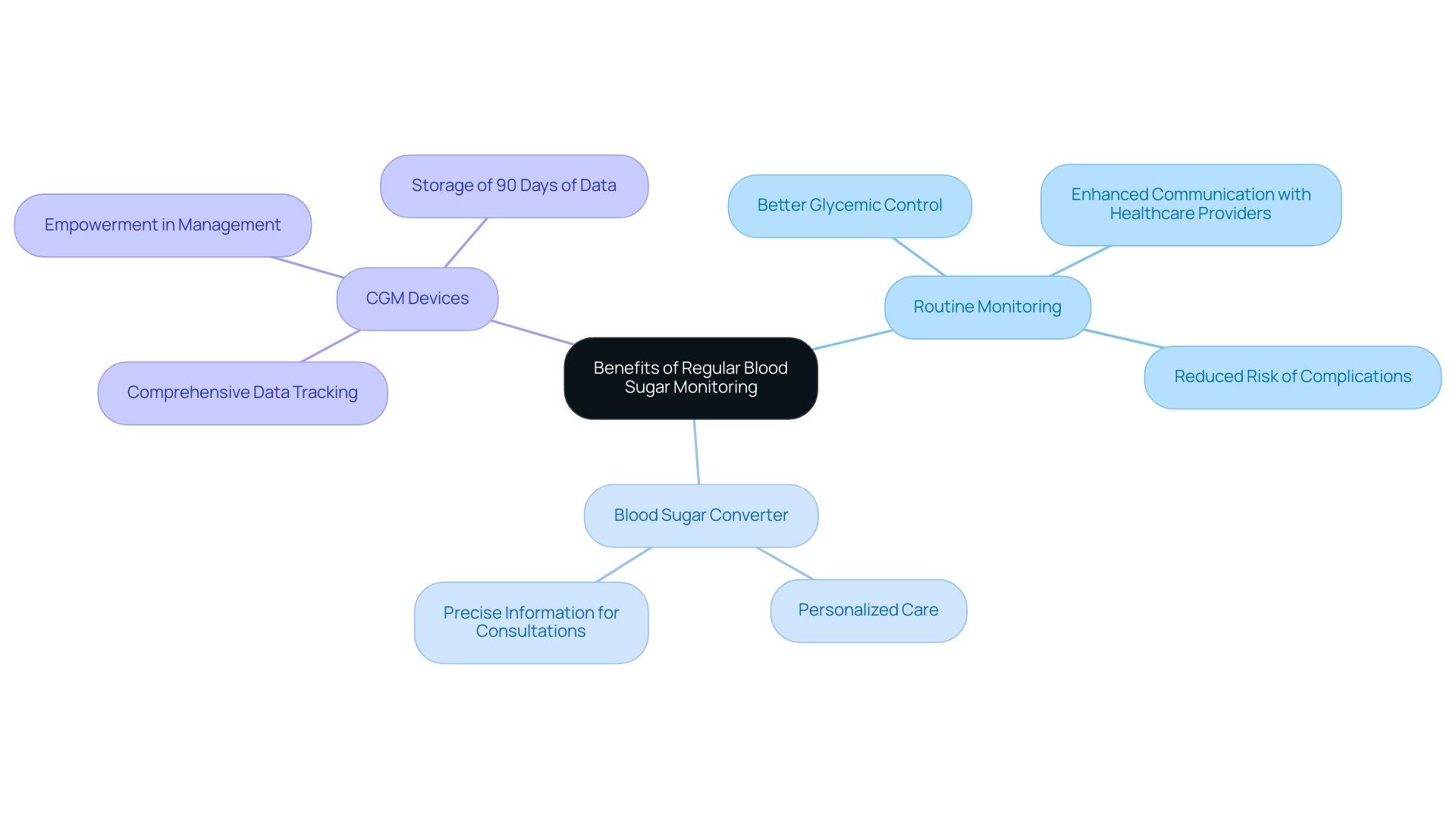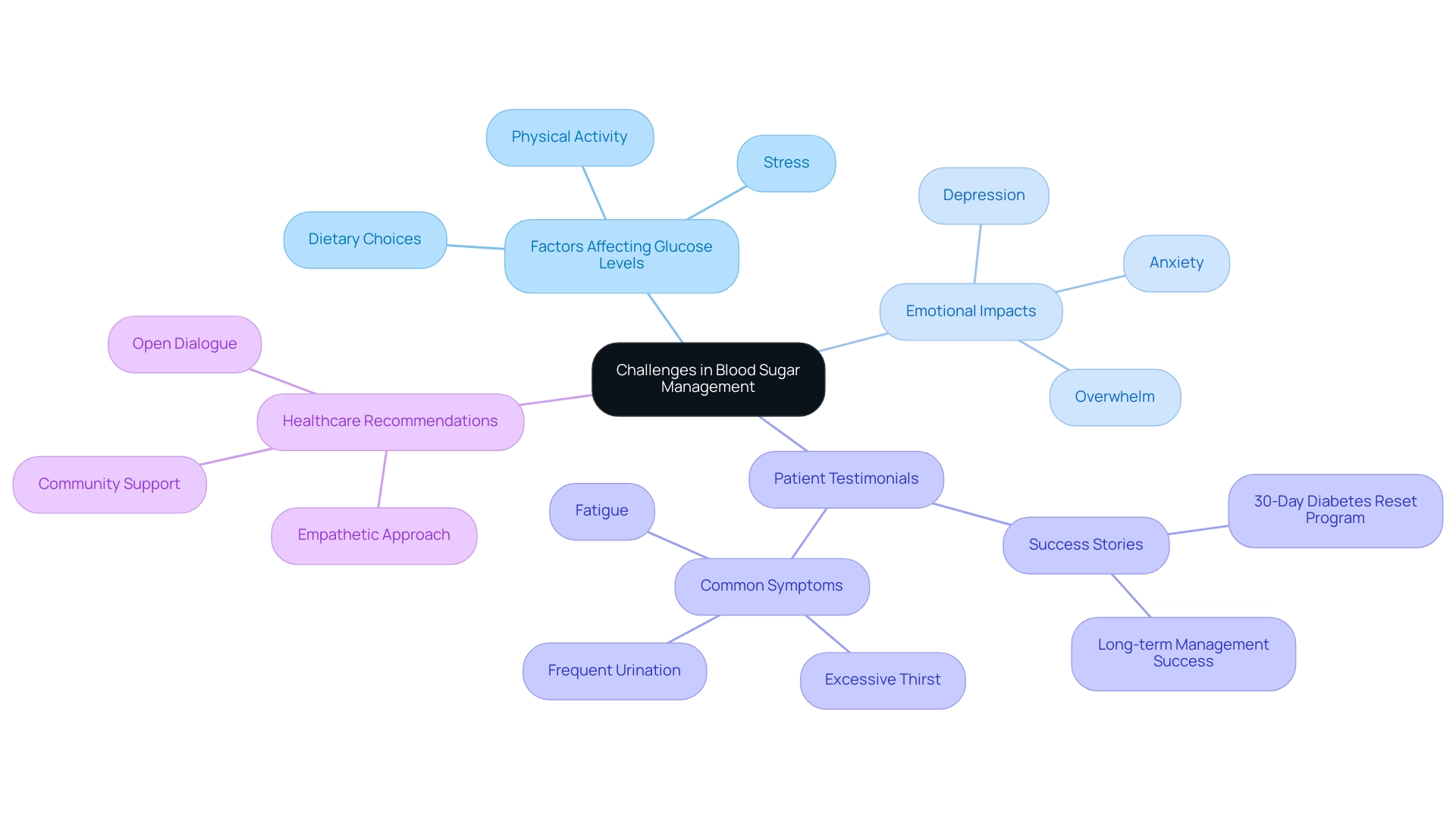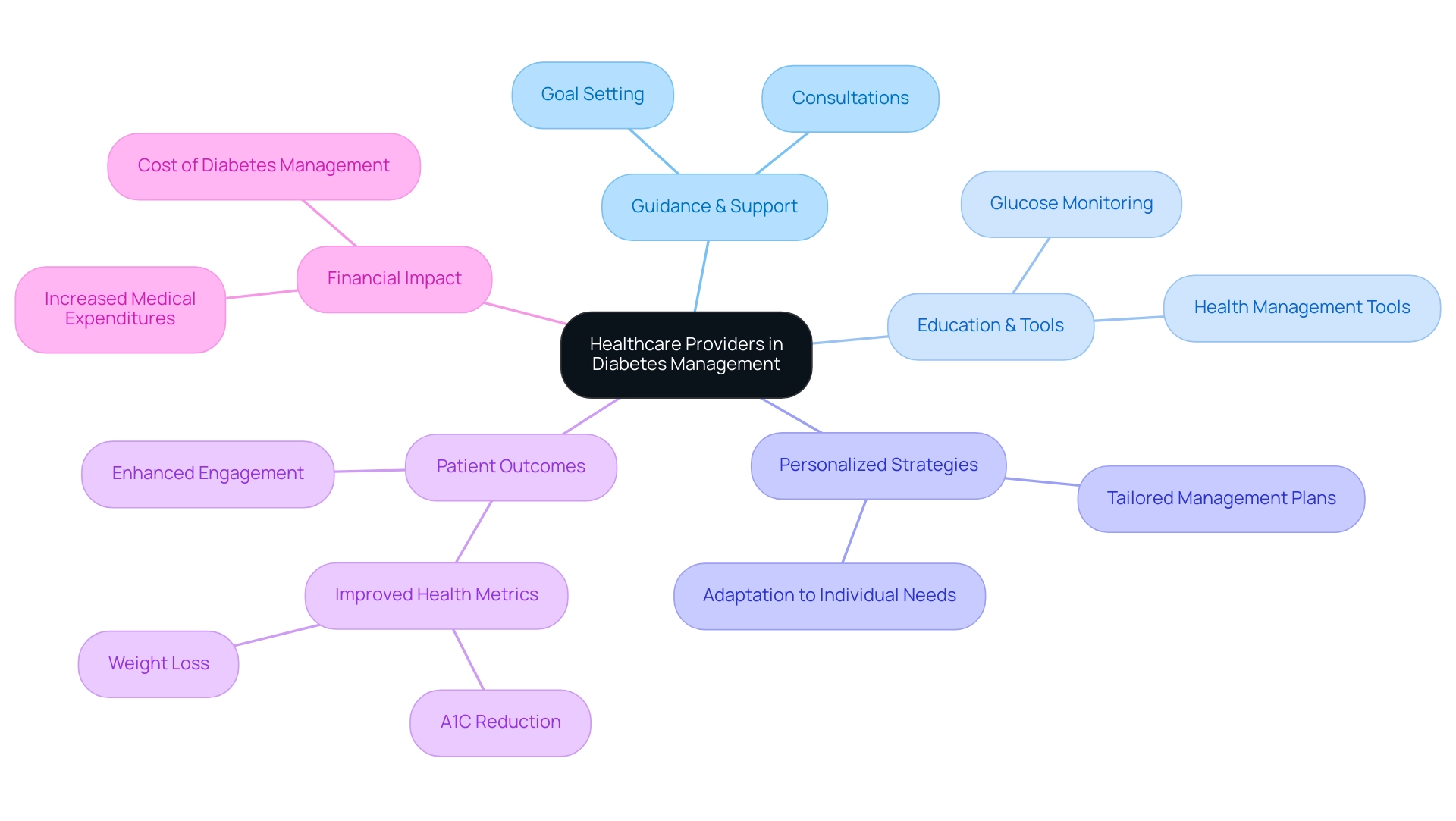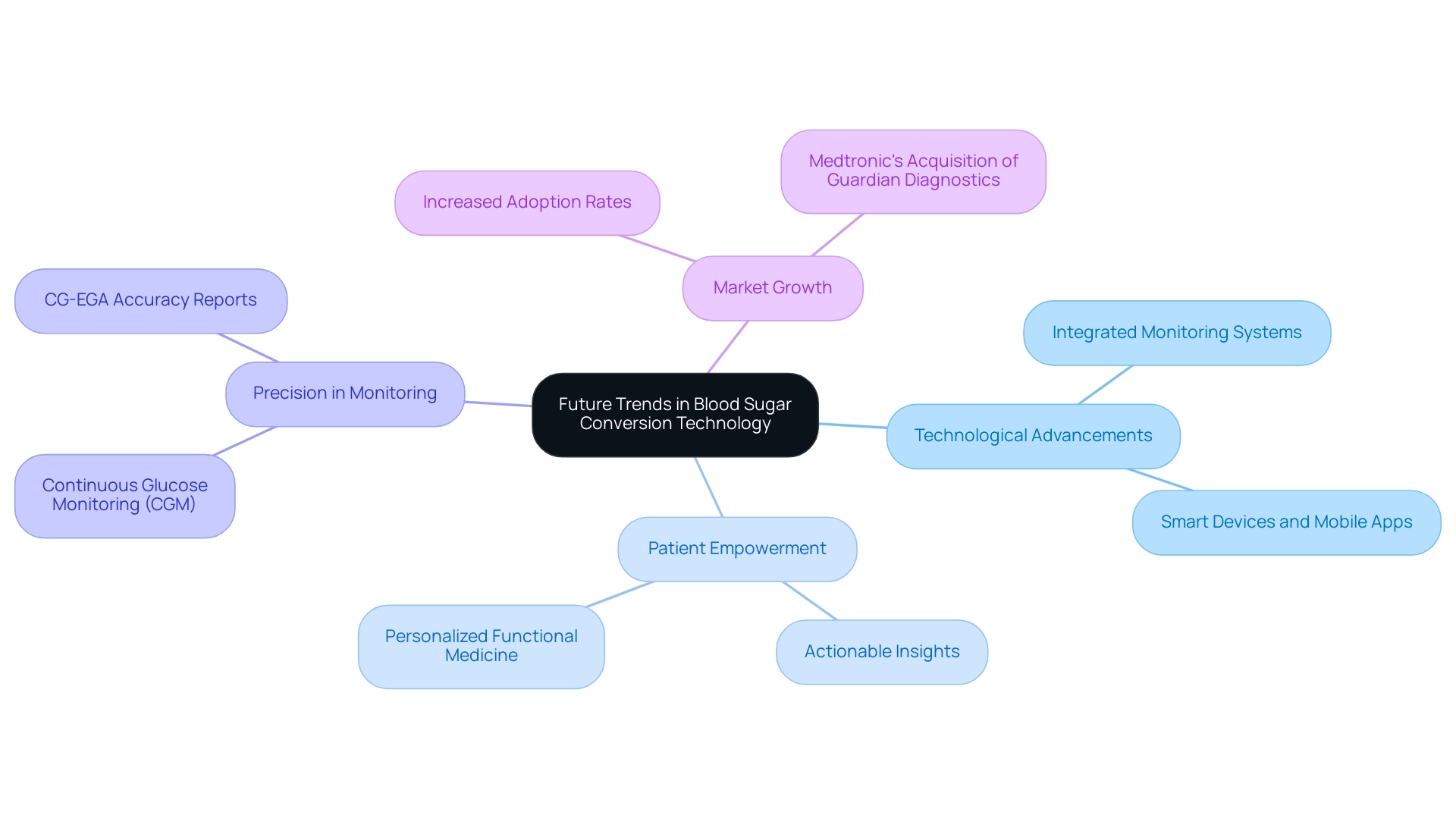Overview
Managing diabetes can often feel overwhelming, and understanding blood sugar levels is a crucial part of that journey. Blood sugar converters are vital tools that help individuals accurately interpret glucose levels across different measurement units. This understanding is essential for making informed health decisions.
It’s important to recognize that these converters empower patients, enhancing their confidence in managing their diabetes. Many individuals find that having this clarity leads to improved health outcomes and a better quality of life. Testimonials and expert insights reveal how precise glucose monitoring can truly make a difference in daily living.
As you navigate your diabetes management, remember that you’re not alone. Embracing these tools can be a significant step toward a healthier future. Consider how blood sugar converters can support you in your journey, helping you feel more in control and informed.
Introduction
In the realm of diabetes management, it’s important to recognize that understanding and accurately interpreting blood glucose levels is paramount. Many individuals find that blood sugar converters emerge as vital tools, enabling them to seamlessly switch between various measurement units. This capability enhances their ability to monitor and manage their health effectively.
With the increasing prevalence of diabetes worldwide, and the diverse measurement standards utilized across different healthcare settings, the significance of these converters cannot be overstated. As patients navigate their health journeys, the integration of blood sugar converters fosters informed decision-making and empowers individuals to take control of their well-being.
This article delves into the importance, types, and practical applications of blood sugar converters, highlighting their role in improving health outcomes and enhancing the quality of life for those living with diabetes.
Understanding Blood Sugar Converters: An Overview
A blood sugar converter is an essential tool for individuals striving to manage their blood glucose readings effectively. It allows for the conversion between different measurement units, primarily from milligrams per deciliter (mg/dL) to millimoles per liter (mmol/L) and vice versa. This conversion is particularly important for patients who may encounter varying measurement standards across different healthcare environments or when utilizing diverse monitoring devices.
It’s important to recognize that the capacity to correctly interpret glucose levels is crucial for effective management of diabetes, especially within a holistic lifestyle framework. Almost 39.5% of adults identified with this condition have non-HDL cholesterol levels of 130 mg/dL or greater, highlighting the necessity for accurate monitoring and management strategies. Furthermore, as the prevalence of diabetes continues to rise globally, with a significant increase noted in recent years, the importance of blood sugar converters becomes even more critical.
Many patients find that understanding global trends in diabetes prevalence can be alarming. A study revealed a near quadrupling of affected adults from 1980 to 2014, underscoring the urgency for effective management tools. Alarmingly, 5,293 children and adolescents aged 10 to 19 years were newly diagnosed with type 2 diabetes, emphasizing the need for early intervention and effective management strategies.
Real-world examples show the positive impact of blood sugar converter devices on managing diabetes. Patients who utilize these tools often report enhanced confidence in interpreting their glucose levels, leading to more informed decisions regarding their health. This empowerment is essential, especially given the rising medical expenses related to health conditions, which grew from $10,179 to $12,022 per individual between 2012 and 2022.
Notably, nearly 60% of the global expenses related to diabetes are borne by low-income and middle-income nations, emphasizing the broader economic impact of this issue.
Looking ahead to 2025, specialists underline the significance of blood sugar converters in diabetes care, emphasizing their role in promoting individual education and self-regulation. Dr. Jason Shumard states, “By providing patients with actionable insights and practical tools, the center fosters an environment where individuals can reclaim their health and well-being, ultimately leading to improved quality of life and reduced reliance on conventional medical interventions.” This highlights the importance of incorporating blood sugar converters into daily routines, allowing individuals to regain control over their health.
Comprehending how to efficiently utilize a blood sugar converter not only aids in better level interpretation but also enhances overall health outcomes for individuals managing their condition. Furthermore, adopting a comprehensive strategy that incorporates personalized nutrition, consistent physical activity, and community assistance can greatly improve management of diabetes, rendering tools like blood glucose converters even more effective.
The Importance of Blood Sugar Converters in Diabetes Management
Blood sugar converters play a crucial role in diabetes management, helping individuals accurately interpret their glucose levels across various measurement systems. This capability is especially important for those who travel frequently or switch healthcare providers, as different regions may use distinct units of measurement. By offering precise conversions, these tools empower patients to make informed choices about their diet, medication, and lifestyle—key components in achieving optimal glycemic control.
It’s important to recognize that precise glucose measurements are vital. Statistics show that adjustments to antidiabetic treatment are necessary when glucose levels drop below 3.9 mmol/L (70 mg/dL). This underscores the need for reliable tools to interpret glucose levels accurately; misinterpretation can lead to inappropriate treatment adjustments and increased health risks.
To ensure accurate capillary glucose testing, individuals should follow these essential steps:
- Prepare the site by cleaning it.
- Use a lancet to obtain a sample.
- Ensure proper collection techniques to avoid contamination.
These measures are crucial for obtaining trustworthy readings.
Many patients find that arterial samples should be preferred over capillary samples for glucose measurements in critically ill adults. Understanding various sampling techniques and their implications for health management is significant for effective care.
Case studies from Dr. Jason Shumard’s practice beautifully illustrate the transformative impact of the blood sugar converter on client outcomes. Participants in the 30-Day Diabetes Reset program have reported remarkable improvements in managing their condition. One individual shared, “I lost 55 lbs.” Another noted, “My A1C started at 9.1; after 8 months, it is now 5.7,” highlighting the program’s success in reversing type 2 diabetes and enhancing overall well-being. Another participant expressed, “I feel so much better… I lost a lot of weight, have more energy, and feel great,” reflecting the holistic approach Dr. Shumard emphasizes.
As Dr. Jason Shumard states, ‘What distinguishes the Integrative Wellness Center is its holistic approach to health, emphasizing personalized care and education instead of merely symptom management.’ This philosophy aligns perfectly with the empowering nature of blood sugar converters.
Professional opinions further reinforce the importance of glucose converters in managing health. Specialists agree that accurate interpretation of glucose levels is critical for effective treatment and prevention of complications. In 2025, experts in glucose management will affirm that using glucose converters not only aids in prompt decision-making but also enhances long-term health outcomes by encouraging better adherence to treatment plans.
In summary, blood sugar converters are indispensable in managing blood glucose levels. They enhance the precision of glucose interpretation, promote informed decision-making, and ultimately improve the quality of life for individuals navigating the complexities of blood sugar management.
Types of Blood Sugar Converters: Tools for Every Need
Managing diabetes can be a challenging journey, but a range of blood sugar converters is available to help you navigate this path effectively. These tools align with integrative functional medicine strategies that emphasize personalized care, catering to your unique needs. From online calculators and mobile applications to physical conversion charts, each option is designed to meet various preferences and requirements.
Online calculators, often found on diabetes-focused websites, allow you to enter your glucose readings and receive immediate conversions. This instant feedback is crucial for making timely decisions about your diet and medication, reflecting a personalized approach to blood sugar management. Many patients find that mobile applications offer even more features, such as tracking sugar levels over time, setting reminders for testing, and analyzing trends in glucose fluctuations.
For instance, continuous glucose monitors (CGMs) provide real-time data, enabling you to detect patterns and adjust your management strategies accordingly. This capability is essential for effective health management. If you prefer a non-digital approach, physical conversion charts remain a practical option. These charts can be easily referenced for quick conversions, especially in situations where technology may not be readily accessible. Each type of blood sugar converter plays a vital role in diabetes management, supporting your holistic health.
A recent study highlighted that when the standard deviation (SD) of glucose levels is 50 mg/dl and the average glucose is 150 mg/dl, the coefficient of variation (CV) is 33%. This statistic underscores the importance of precise and dependable glucose measurements, which can be supported by utilizing the right blood sugar converter. The research titled ‘Accuracy and Reliability in Blood Glucose Measurement’ further emphasizes the need for precise measurements in clinical environments, enhancing the reliability of diagnosis across various contexts.
As technology continues to advance, the latest blood sugar converter tools and applications in 2025 are designed to improve user experience and accuracy. Many patients are increasingly favoring mobile apps over physical charts, with usage statistics indicating a growing trend towards digital solutions in diabetes management. This shift reflects a broader movement towards personalized care, aligning with Dr. Shumard’s commitment to empowering individuals through education and innovative methodologies.
Dr. Shumard states, ‘My dedication to client education and empowerment, combined with my innovative methodologies, offers a unique value proposition in the healthcare landscape.’ Patient testimonials further emphasize the life-changing results and empowerment gained through Dr. Shumard’s program, reinforcing the effectiveness of proper management tools. By understanding the different types available, you can choose the most suitable options for your individual needs, ultimately leading to better health outcomes and an improved quality of life.
How to Use Blood Sugar Converters: A Step-by-Step Guide
Managing diabetes can feel overwhelming at times, but utilizing a blood sugar converter is an easy yet effective way to take charge of your health. Let’s explore some helpful tools that can guide you on this journey:
-
Online Calculators: Start by entering your glucose reading into the designated field. Choose your unit of measurement (e.g., mg/dL or mmol/L), and the calculator will quickly provide the equivalent value in the other unit. This simple step can help you better understand your glucose levels.
-
Mobile Apps: Just like online calculators, mobile apps allow you to input your glucose readings. Many of these apps also track your historical data, which can be incredibly beneficial for spotting trends over time. This feature empowers you to make informed decisions about your health.
-
Fitness Journals: Keeping a fitness journal can be a great way to record your daily glucose levels, dietary choices, and physical activity. This practice encourages reflection on your habits and can help you identify areas for improvement.
-
Pedometers: Using a pedometer can assist you in monitoring your physical activity levels, which is essential for managing blood sugar. Setting a daily step goal can enhance your glucose management efforts.
It’s important to recognize that familiarizing yourself with these processes can significantly boost your confidence in managing diabetes effectively. Research shows that those who consistently use blood sugar converters tend to feel more satisfied with their diabetes management tools. Many individuals have shared success stories about how online calculators have simplified their daily routines, allowing for timely adjustments to their diets and medications.
Moreover, expert advice highlights the importance of integrating these tools into your daily health regimen. By utilizing a blood sugar converter, you gain practical insights that empower you to manage your health better. Dr. Jason Shumard states, “By offering patients actionable insights and practical tools, the Integrative Wellness Center cultivates an environment where individuals can reclaim their wellness and well-being, ultimately leading to enhanced quality of life and diminished dependence on conventional medical interventions.”
Furthermore, understanding the standards for effective glucose management is crucial. For instance, post-operative blood sugar levels exceeding 13.5 mmol/L are above the acceptable range of 8-13 mmol/L. This highlights the importance of using a blood sugar converter to maintain optimal levels.
This holistic approach aligns with a commitment to individual education and empowerment, ensuring you have the resources needed to improve your quality of life and reduce reliance on conventional medical interventions. The real-world impact of Dr. Shumard’s 30-Day Diabetes Reset program illustrates how these tools can empower patients, providing practical examples of their effectiveness in managing diabetes.
By implementing SMART goals—specific, measurable, attainable, relevant, and time-bound—you can further enhance your progress tracking. For instance, you might aim for a consistent daily glucose level below 7.0 mmol/L or adjust your dietary habits based on your readings, such as incorporating more fiber-rich foods. Research indicates that goal-setting persistence scores can positively impact performance; for example, scores improved from 3.4 (SD = 2.0) to 3.8 (SD = 1.9) in specific conditions, demonstrating the effectiveness of structured goal-setting.
Connecting Blood Sugar Levels and A1C: What You Need to Know
Glucose levels and A1C are intricately connected, with A1C serving as a crucial indicator of average glucose levels over the past two to three months. The A1C test quantifies the percentage of hemoglobin that becomes glycated—a process that occurs when glucose binds to hemoglobin in red cells. It’s important to recognize that routine observation of glucose levels is essential for individuals as it acts as a blood sugar converter, helping them understand how daily management practices affect A1C outcomes.
Many patients find that using a blood sugar converter to maintain stable blood sugar levels can significantly reduce A1C percentages, thus lessening the risk of complications linked to their condition. For instance, in 2025, the average A1C levels among individuals with blood sugar issues were observed to hover around 7.5%. This statistic highlights a pressing need for effective monitoring strategies. Recent research, supported by the National Genome Research Institute and the Korean Center for Disease Control and Prevention, underscores the importance of comprehensive screening methods. This research reveals that the relationship between fasting plasma glucose (FPG) and hemoglobin A1c (HbA1c) varies significantly across different regions, emphasizing the necessity for tailored approaches in diabetes management.
Consider the transformative experiences shared by clients of Dr. Jason Shumard’s 30-Day Diabetes Reset program at the Integrative Wellness Center. One individual shared, “I was on 2 different meds that weren’t working and was told that I needed insulin. I lost 55 lbs. My A1C started at 9.1 after 8 months; it is now 5.7.” Another remarked, “I’ve had Diabetes for fourteen years and was taking many drugs for Diabetes, migraines, high pressure, and sinus infections. Now, I feel so much better… I lost a lot of weight, have more energy, and feel great. I am not depressed anymore and I don’t need my meds anymore!” These testimonials illustrate how Dr. Shumard’s holistic approach not only improves A1C outcomes but also acts as a blood sugar converter, enhancing overall well-being and empowering patients to take control of their health.
Expert opinions further reinforce this connection. Endocrinologists emphasize that utilizing a blood sugar converter for diligent tracking is crucial for achieving optimal A1C levels. Nam H. Cho, MD, PhD, observes that the heightened risk linked to managing blood sugar conditions remains significant even after accounting for confounding factors. They promote the integration of advanced monitoring technologies to empower individuals in their health journeys.
As individuals utilize a blood sugar converter to interact with their glucose information, they can make informed choices that directly affect their A1C outcomes, promoting a proactive strategy for managing their condition. This comprehensive understanding of the interaction between glucose levels and A1C is crucial for individuals aiming to improve their health and lessen dependence on traditional medical treatments. Additionally, the effectiveness of A1C as a screening method for blood sugar issues further emphasizes the importance of monitoring these levels regularly.
Benefits of Regular Blood Sugar Monitoring and Conversion
Routine glucose monitoring and the blood sugar converter are essential practices for individuals managing diabetes, offering numerous benefits. By consistently tracking their glucose levels, individuals can identify patterns that help them make timely adjustments to their diet, exercise routines, and medication regimens. This proactive approach not only fosters better glycemic control but also enhances communication with healthcare providers, ensuring that all concerns are addressed.
It’s important to recognize that when individuals understand how to convert their glucose measurements, they can provide precise information during consultations. This clarity ensures they receive personalized care tailored to their unique needs.
The significance of a blood sugar converter in managing glucose levels cannot be overstated. A recent study highlights that patients who regularly monitor their glucose are more likely to achieve optimal glycemic control, reducing their risk of complications such as heart disease and kidney failure. In fact, statistics show that those who engage in consistent monitoring are significantly less likely to face severe health issues related to blood sugar management.
Many patients find that Continuous Glucose Monitoring (CGM) devices, which can store up to 90 days of glucose data, further enhance this process. These devices provide a comprehensive view of blood sugar trends over time, empowering individuals in their management journey.
Moreover, expert opinions stress the importance of integrating digital literacy into self-management training. This approach empowers individuals to effectively monitor and share their data, leading to improved health outcomes. As noted by the Keystone Rural Health Consortia, “by regularly monitoring and managing this condition, you can prevent or delay the onset of complications such as heart disease, stroke, kidney failure, and other serious health problems.”
Real-life stories illustrate the transformative impact of consistent blood sugar monitoring. Many individuals at the Integrative Wellness Center report enhanced glycemic control and a renewed sense of empowerment in managing their health. These experiences showcase the effectiveness of functional medicine in their journeys.
Case studies from the Integrative Wellness Center reveal that personalized care and education, which focus on the underlying causes of type 2 diabetes, lead to remarkable improvements in individuals’ quality of life. Testimonials from satisfied patients, such as one who shared, “Thanks to the Integrative Wellness Center, I’ve regained control over my condition and feel healthier than ever,” highlight their transformative health journeys. This underscores how the center’s approach has enabled them to reclaim their health and reduce reliance on conventional medical interventions.
Ultimately, consistent glucose monitoring and the blood sugar converter are not just beneficial practices; they are vital components of a comprehensive management strategy for diabetes. Embracing these tools can empower you to take charge of your health and enhance your quality of life.
Challenges in Blood Sugar Management: Understanding Patient Experiences
Controlling glucose levels presents significant challenges for individuals living with diabetes. It’s important to recognize that fluctuations in glucose levels can arise from various factors, including dietary choices, stress, and physical activity. These fluctuations not only affect physical health but also contribute to emotional distress.
Many individuals find themselves grappling with anxiety related to testing their blood sugar and harbor fears about potential complications. This emotional burden can complicate their management efforts even further.
The emotional toll of managing this condition is underscored by statistics revealing that many patients feel overwhelmed by their situation. A growing body of evidence suggests that the emotional challenges associated with diabetes can lead to poorer health outcomes, emphasizing the need for comprehensive support systems. For instance, the annual increase in newly diagnosed cases of type 1 and type 2 diabetes among children and adolescents from 2002 to 2018 highlights the urgency of addressing these emotional aspects early on.
Moreover, the plateauing of medications to lower glucose or pressure after 2010 indicates a need for alternative management strategies, as relying solely on pharmacological interventions may not suffice.
Real-world experiences reveal that many individuals grapple with the practicalities of using a blood sugar converter to maintain stable levels. One individual shared their journey of feeling depressed, lacking energy, and struggling with insomnia while on ineffective medications. After joining Dr. Jason Shumard’s 30-Day Diabetes Reset program at the Integrative Wellness Center, they experienced a remarkable transformation, losing 55 lbs and significantly improving their A1C levels from 9.1 to 5.7.
Another patient, who had been managing their condition for fourteen years, reported feeling revitalized after going through the program, stating they no longer needed their medications and felt great.
These testimonials illustrate common symptoms such as excessive thirst, frequent urination, and fatigue, which can disrupt daily life and lead to severe complications if not managed effectively. The risks associated with unmanaged blood sugar levels, including heart attack, stroke, and kidney failure, further underscore the importance of using a blood sugar converter for early detection and proactive management strategies. As noted by Elizabeth Selvin, PhD, MPH, “what we may be seeing is that doctors of individuals with high blood sugar may have backed off a bit on glycemic control, with potentially damaging results,” highlighting the critical need for rigorous management using a blood sugar converter.
Expert opinions suggest that healthcare providers must adopt a more empathetic approach to managing this condition, recognizing the emotional and psychological dimensions of the disease. By promoting open dialogue and urging individuals to share their experiences, healthcare professionals can establish a supportive atmosphere that empowers people to take charge of their health. This community-focused method not only improves education for individuals but also fosters resilience in the face of the difficulties presented by managing blood sugar.
Furthermore, the World Health Organization provides valuable information on the global burden of this condition, emphasizing the importance of prevention and management strategies to address these challenges effectively.
The Role of Healthcare Providers in Diabetes Management
Healthcare providers play a crucial role in effective diabetes management, offering essential guidance, education, and support tailored to individual needs. They assist individuals in setting achievable health goals, analyzing glucose readings, and developing personalized management strategies that adapt to their unique circumstances. Regular consultations with healthcare providers not only allow for necessary adjustments to treatment plans but also enhance engagement and satisfaction among individuals.
It’s important to recognize the significance of glucose monitoring tools, including blood sugar converters. Providers educate patients on how to use these tools effectively, empowering them to take an active role in managing their health. This proactive approach is supported by recent statistics indicating that 80.6% of U.S. adults with diagnosed conditions also face challenges such as high blood pressure, underscoring the need for comprehensive care strategies.
Many patients find that average medical expenditures for those with diagnosed health issues related to blood sugar are 2.6 times higher than costs would be without this condition, highlighting the financial burden of managing it.
Consider the inspiring case studies and testimonials from individuals at Integrative Wellness Center that illustrate the transformative impact of a holistic approach to diabetes management. One individual shared, “I was on 2 different meds that weren’t working and was told that I needed insulin. After joining this program, I lost 55 lbs, and my A1C improved from 9.1 to 5.7!”
Another individual noted, “I feel so much better and going through the cleanse helped in so many ways. I lost a lot of weight, have more energy, and feel great. I am not depressed anymore and I don’t need my meds anymore!”
These experiences highlight the effectiveness of Dr. Jason Shumard‘s 30-Day Reset program in reversing type 2 diabetes and promoting holistic health.
Overall, the dedication of healthcare professionals to individual education and support is essential in navigating the complexities of managing this condition. It ensures that people are equipped with the knowledge and resources necessary to reclaim their health and well-being. As Dr. Jason Shumard states, “By providing patients with actionable insights and practical tools, the center fosters an environment where individuals can reclaim their health and well-being.
Future Trends in Blood Sugar Conversion Technology
The future of glucose conversion technology, particularly the blood sugar converter, holds great promise for transforming health management for those grappling with insulin issues. With an emphasis on enhancing precision, availability, and user experience, innovations are emerging that can truly make a difference. For instance, integrated glucose monitoring systems are now available that not only offer real-time feedback but also act as a blood sugar converter, turning readings into actionable insights. This capability is vital, especially considering that approximately 322 million people worldwide live with type II conditions, as reported by the International Diabetes Federation. The need for effective monitoring solutions has never been more urgent.
At the Integrative Wellness Center, founded in 2005 in San Diego, Dr. Jason Shumard highlights the importance of merging these technological advancements with personalized functional medicine approaches. Smart devices that connect seamlessly with mobile applications are on the rise, enabling effortless monitoring through a blood sugar converter. These advancements are designed to encourage greater involvement, empowering individuals to take control of their diabetes management.
Many patients find that continuous glucose monitoring (CGM) technologies are being refined to enhance their accuracy and reliability. Acting as a blood sugar converter, these technologies address crucial blood glucose ranges like hypoglycemia, euglycemia, and hyperglycemia. CG-EGA provides separate accuracy reports for these ranges, emphasizing the significance of precision in monitoring solutions. A recent review of CGM technologies underscores how these factors can enhance patient compliance and overall benefit.
Moreover, the anticipated growth of smart health management devices, including the blood sugar converter, is significant. Industry experts forecast a surge in adoption rates as technology becomes increasingly user-friendly and integrated into daily life. Notably, Medtronic’s acquisition of Guardian Diagnostics for $2.1 billion in 2023 signals a pivotal moment in the industry, reflecting the growing investment in blood sugar converter technology.
As Dr. Jason Shumard expresses, “By providing patients with actionable insights and practical tools, the center fosters an environment where individuals can reclaim their health and well-being.” This theme of patient empowerment resonates throughout advancements in management technology. These innovations are not merely theoretical; they are being driven by real-world solutions that prioritize patient comfort and ease of use. As these technologies evolve, they promise to reshape the landscape of care for this chronic condition, ultimately leading to improved health outcomes and a better quality of life.
Additionally, our program is thoughtfully designed to equip you with the tools and knowledge necessary to reverse your type 2 diabetes, guiding you toward a healthier, happier life.
Conclusion
The exploration of blood sugar converters highlights their essential role in diabetes management, providing individuals with the tools they need to navigate their health with confidence. These converters make it easy to switch between different measurement units, allowing patients to interpret their glucose levels accurately, no matter the healthcare setting. It’s important to recognize that, in a world where diabetes prevalence is increasing, reliable management strategies are more crucial than ever.
By utilizing blood sugar converters, individuals can make informed decisions about their diet, medication, and lifestyle choices—key factors for achieving optimal glycemic control. Integrating these tools into daily routines not only enhances health outcomes but also fosters a sense of autonomy among patients. Many patients find that the variety of converters available—ranging from online calculators to mobile applications and physical charts—ensures there’s an option that fits their unique preferences, further supporting personalized care.
As technology continues to advance, the future holds promising possibilities for even more innovative solutions that improve user experience and accuracy. The commitment of healthcare providers to patient education and support is essential in guiding individuals through the complexities of diabetes management. Ultimately, the proactive use of blood sugar converters, along with continued engagement with healthcare resources, can lead to a better quality of life for those living with diabetes, helping them reclaim control over their health and well-being.
Frequently Asked Questions
What is a blood sugar converter and why is it important?
A blood sugar converter is a tool that allows individuals to convert blood glucose readings between different measurement units, primarily from milligrams per deciliter (mg/dL) to millimoles per liter (mmol/L) and vice versa. It is important for managing diabetes effectively, especially for patients who encounter varying measurement standards across different healthcare environments or monitoring devices.
How does a blood sugar converter help in diabetes management?
A blood sugar converter helps individuals accurately interpret their glucose levels, empowering them to make informed decisions about their diet, medication, and lifestyle. This is crucial for achieving optimal glycemic control, especially when different regions may use distinct units of measurement.
What are the statistics regarding diabetes prevalence mentioned in the article?
The article notes a near quadrupling of adults affected by diabetes from 1980 to 2014. It also highlights that 5,293 children and adolescents aged 10 to 19 years were newly diagnosed with type 2 diabetes, emphasizing the need for early intervention and effective management strategies.
What are the economic implications of diabetes management?
Nearly 60% of global expenses related to diabetes are borne by low-income and middle-income nations. The medical expenses for individuals with diabetes grew from $10,179 to $12,022 between 2012 and 2022, indicating a significant economic burden associated with managing the condition.
What role do blood sugar converters play in patient education and self-regulation?
Blood sugar converters promote individual education and self-regulation by providing patients with actionable insights and practical tools. This empowers individuals to reclaim their health and well-being, leading to improved quality of life and reduced reliance on conventional medical interventions.
What steps should individuals follow for accurate capillary glucose testing?
To ensure accurate capillary glucose testing, individuals should: Prepare the testing site by cleaning it. Use a lancet to obtain a blood sample. Follow proper collection techniques to avoid contamination.
How do blood sugar converters enhance patient outcomes?
Blood sugar converters enhance patient outcomes by improving the accuracy of glucose interpretation, which leads to more informed decision-making regarding health management. Case studies show that participants in diabetes management programs have reported significant improvements in their condition after using these tools.
What types of blood sugar converters are available for diabetes management?
There are various types of blood sugar converters available, including online calculators, mobile applications, and physical conversion charts. Online calculators provide immediate conversions, mobile apps offer features like tracking and reminders, and physical charts serve as practical references when technology is not accessible.
What is the future outlook for blood sugar converters in diabetes care?
By 2025, experts emphasize the importance of blood sugar converters in diabetes care, noting their role in promoting better adherence to treatment plans and enhancing long-term health outcomes. As technology advances, newer tools and applications are expected to improve user experience and accuracy in diabetes management.
